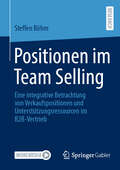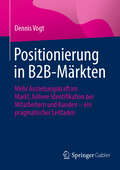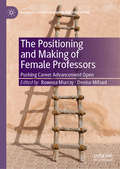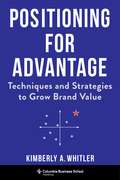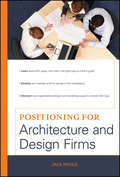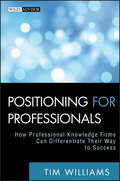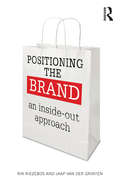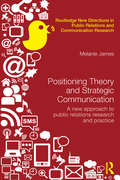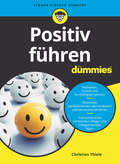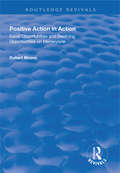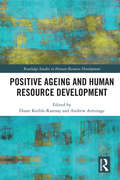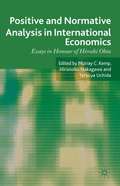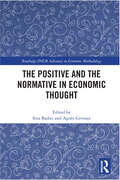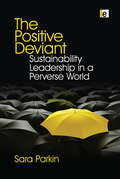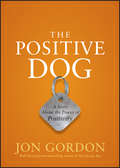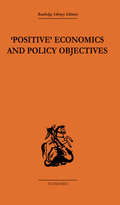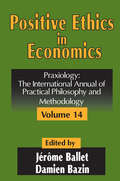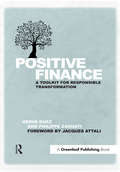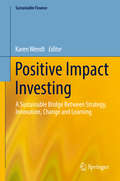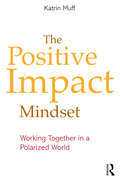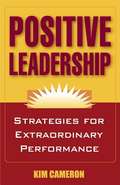- Table View
- List View
Positionen im Team Selling: Eine integrative Betrachtung von Verkaufspositionen und Unterstützungsressourcen im B2B-Vertrieb
by Dr. Steffen BöhmDas vorliegende Buch beschäftigt sich mit der Verkaufsunterstützung im B2B-Bereich und zeigt dem Leser Möglichkeiten auf, den Unternehmenserfolg im komplexen Verkauf zu vergrößern. Es betrachtet verschiedene Positionen innerhalb eines Verkaufsteams und beschreibt das Zusammenspiel der am Verkauf beteiligten Akteure. Dazu verknüpft der Autor zwei Forschungsfelder und die dazugehörigen Praxistrends. Er zeigt den Wandel der Klassifizierung von Verkaufspositionen und weiteren Verkaufsunterstützungsressourcen, als auch den Wandel von sogenannten Verkaufsstilen oder Verkaufsansätzen. Fünf empirische Studien führen zu neuen, bisher nicht gezeigten Erkenntnissen. Als überraschendes Ergebnis führt der Autor dem Leser vor Augen, dass verkaufsunterstützende Positionen in Form von Spezialisten wichtiger für den Verkaufserfolg sind als die Verkäuferposition selbst. Darauf aufbauende Anwendungsfälle in führenden Unternehmen sowie Empfehlungen und Orientierungshilfen für die Ausrichtung der Vertriebsorganisation oder als Grundlage für Investitionsentscheidungen helfen dem Leser, die Erkenntnisse in der Unternehmenspraxis umzusetzen.
Positionierung in B2B-Märkten: Mehr Anziehungskraft im Markt, höhere Identifikation bei Mitarbeitern und Kunden – ein pragmatischer Leitfaden
by Dennis VogtDieses Buch bietet eine pragmatische Anleitung für die Entwicklung und konsequente Umsetzung einer klaren Positionierung in B2B-Märkten. Eine Positionierung, die sich über das gesamte Leistungsspektrum sowie über alle Kontaktpunkte mit Zielgruppen erstreckt und zudem die Mitarbeitenden mitnimmt. Der Autor beleuchtet im ersten Schritt die zentralen Mechanismen, die Zielgruppen im Zuge von Kaufentscheidungsprozessen in B2B-Märkten beeinflussen. Im zweiten Schritt zeigt er, wie B2B-Anbieter eine wirkungsvolle Positionierung mit klarer Differenzierung erarbeiten können. Im dritten Schritt wird aufgezeigt, wie B2B-Anbieter diese Positionierung konsequent über ihr gesamtes Leistungsspektrum sowie alle relevanten Kontaktpunkte mit Zielgruppen aktivieren können. Im vierten und letzten Schritt geht es darum, wie B2B-Anbieter ihre Positionierung in den Köpfen und Prozessen der eigenen Organisation konsequent verankern können. Nur so kann der nachhaltige Markterfolg gelingen. Erfolgreiche B2B-Unternehmen haben erkannt: die fortschreitende Globalisierung, die permanent zunehmende Digitalisierung, und die rasante Zunahme an Innovationen zwingt zu einem fokussierten Marktauftritt. Dieser muss mit überzeugenden Produkt- und Service-Leistungen und ebenso überzeugenden Erlebnissen für die Kunden an jedem Touchpoint unter Beweis gestellt werden. Wie diese Fokussierung in der Strategie-Entwicklung und der internen und externen Kommunikation gelingt, zeigt dieses Buch.
Positionierungen nachhaltigen Verhaltens am Arbeitsplatz: Eine rekonstruktive Untersuchung des öffentlichen Dienstes
by Christian Thomas ScheidingIn diesem Open-Access-Buch werden die Nachhaltigkeitspositionierungen von Angestellten im öffentlichen Dienst im Kontext organisationaler Nachhaltigkeitstransformationen untersucht. Mithilfe der Dokumentarischen Methode wird ein qualitativ-rekonstruktiver Ansatz verfolgt, um die vielschichtigen handlungsleitenden Orientierungen der Positionierungsfindung offenzulegen. Hierfür werden die Komplexität, die Kontextabhängigkeit und die Wechselwirkungen zwischen individuellen, sozialen und organisationalen Ebenen analysiert. Zentral ist das entwickelte Sphärenmodell, das die endogenen (individuellen), mesogenen (sozialen) und exogenen (organisationalen) Dimensionen der Positionierungen integriert. In und zwischen diesen Sphären positionieren sich die Angestellten in Spannungsfeldern zwischen Selbstreflexion, sozialen Dynamiken und organisationalen Vorgaben. Die Studie liefert einen wertvollen Beitrag zum Verständnis der komplexen Vorgänge und Interdependenzen, die für die erfolgreiche Umsetzung nachhaltiger Veränderungen in öffentlichen Organisationen entscheidend sind und bietet so eine bereichernde Lektüre sowohl für die Wissenschaft als auch für alle, die sich mit der Transformation von Organisationen hin zu mehr Nachhaltigkeit beschäftigen.
Positioning
by David E. BellDescribes the importance of positioning for retail outlets. Sections of the note deal with aspects of the retailing mix.
The Positioning and Making of Female Professors: Pushing Career Advancement Open (Palgrave Studies in Gender and Education)
by Rowena Murray Denise MifsudThis book explores the experiences and perspectives of female professors. Analysing the gendering of this process using various theoretical perspectives, this edited collection examines the active ‘making’ of careers, and how this has been possible. The editors and contributors cut across institutions, cultures and continents to seek to understand how women navigate the gendered process of becoming a professor, with each chapter applying a different theoretical or methodological approach to her experience. The chapters are not mere descriptions of career trajectories, but analytic narratives anchored within distinct theoretical and philosophical frameworks. In turn, they shed important light on how – and if – institutional structures and systems are adapting to move towards gender equality. Offering practical advice as well as thoughtful reflection, this book will be of especial interest to early career female academics.
Positioning for Advantage: Techniques and Strategies to Grow Brand Value
by Professor Kimberly A. WhitlerMost of us have an intuitive sense of superior branding. We prefer to purchase brands we find distinctive—that deliver on some important, relevant dimension better than other brands. These brands have typically achieved positional advantage. Yet few professionals have had the formal training that goes beyond marketing theory to bridge the “theory-doing gap”—understanding the specific techniques and strategies that can be used to create brands that attain positional advantage in the marketplace.Positioning for Advantage is a comprehensive how-to guide for creating, building, and executing effective brand strategies. Kimberly A. Whitler identifies essential marketing strategy techniques and moves through the major stages of positioning a brand to achieve in-market advantage. Introducing seven tools—from strategic positioning concepts to strategy mapping to influencer maps—Whitler provides templates, frameworks, and step-by-step processes to build and manage growth brands that achieve positional advantage. This book presents real-world scenarios, helping readers activate tools to increase skill in creating brands that achieve positional advantage. Brimming with insights for students and professionals alike, Positioning for Advantage helps aspiring C-level leaders understand not only what superior branding looks like but also how to make it come to life.
Positioning for Architecture and Design Firms
by Jack ReigleAn essential guide for a firm of any size to effectively position itself in the marketplace For an architecture or design firm to survive and prosper in the new economy, it needs to redefine and reinvigorate its position in the marketplace. With dozens of how-to cases, examples, and guidelines, Positioning for Architecture and Design Firms provides the entire menu of tools, plus the inspiration needed, for making the changes required to stay competitive in the design world. Offering strategies for leveraging a firm's strongest assets into the formulation of a successful long-term plan, this book breaks with tradition to introduce the latest concepts specifically developed for building future business opportunities in an unstable economic landscape marked by shifts in competition, technology, and client expectations. With a wealth of information targeting the subject of positioning, readers will learn: Why the aftershocks of the Great Recession are likely to linger, and what you can do about it in relation to your firm's success How the coming generational shift will change the design business What positioning is, and how it needs to be developed to support and implement your strategic vision How your firm can establish a robust identity and operating model The importance of your firm's essential purpose How to turn your marketing department into a true marketing system, transforming it from production mode into an integrated positioning machine Why it is important to engage in advanced research and open innovation initiatives Addressing issues of firm identity, including an understanding of how to create the market positioning desired, Positioning for Architecture and Design Firms shows how a design firm-large or small, new or well established-can position itself to gain greater control over its destiny, and reach loftier levels of achievement. Learn about firm types, and match the right type to a firm's goals Develop and maintain a firm's identity in the marketplace Discover how organizational design and marketing support a chosen firm type
Positioning for Professionals: How Professional Knowledge Firms Can Differentiate Their Way to Success (Wiley Professional Advisory Services #6)
by Tim WilliamsIt's not the best companies that prevail in the marketplace, but rather the best brands. The goal of business strategy is not just to be better, but different. Learn how to build a differentiating value proposition by clearly and carefully defining your brand boundaries: Calling, Competencies, Customers, and Culture. Positioning for Professionals shows how a well-defined value proposition can help professional service firms create their own success instead of copying the success of others, including such concepts as: How and why professional service brands become homogenized Why standing for everything is the same as standing for nothing Why there's no such thing as full service Deep and narrow as a strategic imperative Why it's better to be a profit leader than a market leader Differentiation and price premiums How to map your brand on the matrix of relevance and differentiation How to define a value proposition that will make your firm intensely appealing to the customers who want you for what you do best Based on the proven premise that the most profitable business strategy is not to aim at the center of the market, but rather at the edges, Positioning for Professionals is written for leaders, managers, and other senior executives of service companies in with a particular emphasis on professional service firms.
Positioning the Brand: An Inside-Out Approach
by Rik Riezebos Jaap van der GrintenPositioning is hot. Not only in the realm of consumer goods manufacturers, but also for other companies, institutions, governments and even individual persons. An explosion of good quality products on the market and targeted media and advertising campaigns has led to an increasing interest from organizations as to how to strategically position their brand. Up to now, only a few books on positioning were published. Positioning the Brand picks up the gauntlet with an approach based on two fundamental choices: Firstly, the book was written from the perspective of the brand manager, and has therefore been shaped as a practical roadmap. Secondly, this book advocates a new stance on positioning, teaching the reader to look from the inside-out, instead of adopting the usual outside-in methodology. This inside-out approach departs from an analysis of the corporate identity, enabling better fulfilment of external positioning, and ensuring internal support. This book is intended for (future) managers, marketing professionals and communication professionals responsible for the commercial success and reputation of a brand. The contents have a practical set-up, reinforced by engaging examples, and enable the reader to individually complete a positioning process.
Positioning Theory and Strategic Communication: A new approach to public relations research and practice (Routledge New Directions in Public Relations & Communication Research)
by Melanie JamesIn public relations, people talk about positioning an idea, a persona, a political ideal, an ideology – but what are they talking about? Why do some positions taken by organizations crystallize in the minds of audiences, while others fail? Whilst positioning is not something new in public relations, this book is the first to explicate what it involves, how it works and how to do it. This is the first in-depth exploration of the possibilities of Positioning Theory for the public relations field and it adds a new perspective to the growing body of multidisciplinary work in this rich theoretical area, moving the discussion away from the traditional communication plans of previous decades, which fail to accommodate the changing media and opinion landscapes. The author pulls together various strands of socio-cultural theory into an analytical framework, providing readers with a tool to analyse the organizational implications of public relations decisions, guiding strategic decision making through realistic scenario planning. This thought-provoking book provides an alternative path to studying communication in increasingly complex environments and as such, will be vital reading for researchers and educators, advanced communication and public relations students, and for senior public relations practitioners.
Positiv führen für Dummies (Für Dummies)
by Christian ThieleIst es Ihnen wichtig, dass Arbeit Ihnen und auch Ihrem Team Freude macht? Haben Sie Vertrauen zu Ihren Mitarbeitern, kennen Sie deren Stärken und setzen Sie diese gezielt ein? Möchten Sie, dass Ihre Mitarbeiter verstehen, wofür Sie arbeiten und die Werthaftigkeit ihres Tuns erkennen? Dann sind Ihnen die Grundprinzipien des Positiven Führens bereits vertraut. Christian Thiele erklärt Ihnen, wie Sie sich, Ihr Team oder auch das ganze Unternehmen mit dieser modernen Form von Führung motivieren und so gemeinsam Ihre Ziele erreichen. Und Ihren gemeinsamen Erfolg dann kräftig feiern, denn auch das gehört zum Positiven Führen!
Positive Action in Action: Equal Opportunities and Declining Opportunities on Merseyside (Routledge Revivals)
by Robert MooreFirst published in 1997, this volume describes very clearly the various government policies to promote equal opportunity and the context of urban policy in which they have to be implemented. Robert Moore’s important study addresses the key issue of equal opportunities through a case study of events when a change in government policy appeared to hold out the prospect of new jobs for a highly deprived inner city area. It is a model for all social research of this kind. The result is a very detailed and objective analysis of the problem of implementing equal opportunity policies in practice.
Positive Ageing and Human Resource Development (Routledge Studies in Human Resource Development)
by Diane Keeble-Ramsay Andrew ArmitagePositive Ageing and Human Resource Development seeks to introduce readers to some of the major cultural issues that the current demographic changes of the workforce as the national default retirement age within the UK has moved from 60 to 67 and beyond represent for the workplace. This phenomenon is happening in other economies. It recognises there are social shifts in terms of the psychological contract and expectations of different sets of workers. Rather than seeking to extend ideas around multi-generational research eg millennials and generation X/Y, it provides some contributions and commentary which may inform employers, HR professionals and those interested in Human Resource Development (HRD) when considering how to plan for these challenges. It considers the concerns that HRD thinking has largely been focussed upon the development of leaders or managing people, rather than how such sociological shifts may impact upon the nature of work and subsequent productivity. It recognises that many companies have failed to plan their people management strategies and talent management approaches to cope with this shift largely given their uncertainty how to address. It takes a set of contributions then, which focus upon different issues broadly based around age, in order to provide illustrations of some of the areas for discourse of the lived experiences of those affected by the probability of working into their late 60s or potentially even late 70s. Much of this is focussed around women’s working lives as the impact of later working represents a number of peculiar issues around the valuing of women’s work and its contributions.
Positive and Normative Analysis in International Economics
by Murray Kemp Hironobu Nagakawa Tatsuya UchidaThis volume addresses important issues in international economics with contributions from an array of prominent researchers a manifestation of Hiroshi Ohta's cross-border research network and his passionate dedication to economics. Contributions range from studies on positive and normative trade theory, innovation in international trade and interactions between domestic and foreign firms and industries, to studies of a more empirical nature. The empiricalcontributions focus on preferential trading arrangements, global imbalances and exchange rates, as well asprovidingan in-depth analysis of the Japanese economy. The featured topics are explored from both positive and normative perspectives. Positive analysis describes how the economy functions, dealing primarily with what 'is'. Normative analysis is concerned with what 'should be'. This combined approach enables the formation of a base from which credible policy evaluation can take place. "
The Positive and the Normative in Economic Thought (Routledge INEM Advances in Economic Methodology)
by Sina Badiei Agnès GrivauxThe book responds to the need for greater clarity regarding the relationship between descriptive, evaluative and prescriptive approaches within positive and normative economics. It also analyses the entanglement between evaluative and prescriptive perspectives within several theoretical frameworks in normative economics such as social choice theory, the capability approach, behavioural welfare economics and various theories of justice. It provides a forum for discussion between various schools of economic thought and several theoretical frameworks on the relationship between the study of facts, norms and values, with particular emphasis on classical political economy, the Marxian school of economics, the Frankfurt School, the Austrian school, the Chicago school, rational choice theory, expected utility theory, behavioural economics, experimental economics, development economics, welfare economics, public economics, constitutional political economy, the capability approach and politico-economic theories of justice. Given the scope of questions treated in this book, it will be of interest to economists, historians of economic thought, political philosophers and philosophers of science, especially those interested in the philosophy and epistemology of economics.
The Positive Deviant: Sustainability Leadership in a Perverse World
by Sara ParkinAn economy low in carbon and high in life satisfaction will require thousands, if not millions of exceptional leaders. This book is the first to bring together sustainability knowledge with the leadership skills and tools to help you become one of those leaders. In it you will find everything you need to get started straight away, and to grow your effectiveness, even in a world that remains perversely intent on the opposite. Whether you are new to the whole idea of sustainability, or reasonably well informed but not entirely confident about what to do for the best, this guide will help you 'do' sustainability. Free of checklists and policy recommendations, the focus is on you, and on developing your capacity to identify the right thing to do wherever you are and whatever your circumstances. This is essential reading for those in or aspiring to sustainability-literate leadership, and a must for all those teaching leadership and management.
The Positive Dog: A Story About the Power of Positivity
by Jon GordonDiscover the benefits of being positive. We all have two dogs inside of us. One dog is positive, happy, optimistic, and hopeful. The other dog is negative, mad, sad, pessimistic, and fearful. These two dogs often fight inside us, but guess who wins the fight? The one you feed the most. So begins the story about a negative mutt named Matt and a big dog named Bubba who teaches him how to feed himself with positivity each day and in the process Matt transforms his own life and the shelter they call home.The Positive Dog is an inspiring, heartwarming story that not only reveals the strategies and benefits of being positive but also an essential truth for humans: Being positive doesn't just make you better. It makes everyone around you better.
Positive Economics and Policy Objectives (Routledge Library Editions)
by T.W. HutchisonThis book examines important issues on the relationship between economics and political values or ideologies, by analysing the main branches of economic theory in an historical perspective and their impact on economic policy.The book is structured as follows:Part I: Positive Economics?1. The Positive-Normative Distinction in the History of Economic ThoughtPart II: Policy Objectives2. The Objectives of Economic Policies: An Historical Review
Positive Energy Buildings: Concepts, Challenges and Opportunities (Green Energy and Technology)
by Rita Lavikka Hassam Ur Rehman Francesco Reda Abdul Samad KaziThis book investigates positive energy buildings (PEBs). It provides and describes them, explains why they are important in the fight against climate change and discusses how they might be implemented. This book begins by contextualizing PEBs, discussing concepts, definitions and how they may be included by planning authorities in development plans. It then thoroughly explains what PEBs are and their impact on a climate-neutral economy. The book discusses technological, economic, societal and regulatory challenges and opportunities in employing PEBs, before concluding with possible scenarios for implementing them. This book is of use to researchers, practitioners, and policy makers interested in local and decentralized energy, as well as plans to achieve carbon neutrality.
Positive Ethics in Economics: Volume 14, Praxiology: The International Annual of Practical Philosophy and Methodology (Praxiology Ser. #Vol. 14)
by Jérôme Ballet Damien BazinEconomics is often accused of being "a-ethical" - lacking a moral perspective - if not altogether immoral. Its detractors criticize economic models of pure and perfect competition, and claim that economics should be concerned with social effects and strive to be equitable. Yet, these critics fail to understand that the discipline has many dimensions. Economics has also developed a group of concerns directly related to ethics. The presence of practical ethics is evident in the economic analysis of behaviour that incorporates ethical preference, altruism, and a responsible calculation based on norms. It is fair today that economics differentiates ethics from purely financial matters, and the discipline can be associated with morality in man's daily life. Volume 14 of the distinguished "Praxiology" series, examine the concept of positive ethics in economics. While normative ethics moralizes economics, trying to render it more "just," positive ethics is first and foremost a model for the construction of theoretical economic reasoning: it reflects on ethical practices within economics, and introduces a model of reasoning that takes individual ethical behaviour and its after-effects into account. The book is divided into three parts. In "Altruism," the contributors discuss the notion of unselfish concern for the welfare of others, and its place in economic practice. In "Commitment," the authors discuss reason as being central to economic theory, as well as the position of ethical behaviour. In "Responsibility," the idea that man is not an island unto himself, but a being involved in a set of relationships, is examined. If a person is simultaneously responsible for himself and others, then how far does his responsibility extend? "Essays on Positive Ethics in Economics" is thought-provoking volume that will be of interest to economists, policymakers, philosophers, and students of ethics and morality.
Positive Finance: A Toolkit for Responsible Transformation
by Hervé Guez Philippe ZaouatiFor some, finance is the enemy: solely responsible for the global financial crisis and symbolic of an outdated model that is catapulting us toward social and ecological ruin. Such a view can seem tempting. The 2007-2008 meltdown of the financial system was intimately bound to the financialization of the economy and its consequences. However, in reality the crisis in finance is an indicator that our economic model is obsolete. It is possible to imagine another way, which would consist of seeing finance as a “toolkit” for building a solution to the crisis.Positive Finance presents a way to transform the economic model and reduce the ever-widening gulf of inequality, while taking into account environmental constraints. In order to achieve this, the authors argue that we must re-envision the allocation of capital in order to support social and technological innovations, to design and build sustainable infrastructure, and to finance the energy transition. Reinvented, finance could become a powerful lever for setting these transformations in motion. This book is dedicated to proving that such leverage is within reach: here, the authors present a toolkit for putting money to work in the general interest.
Positive Impact Investing: A Sustainable Bridge Between Strategy, Innovation, Change and Learning (Sustainable Finance)
by Karen WendtThis book illustrates the impact that a focus on environmental and social issues has on both de-risking assets and fostering innovation. Including impact as a new cornerstone of the investment triangle requires investors and clients to align interests and values and understand needs. This alignment process functions as a catalyst for transforming organizational culture within an organization and therefore initiates the external impact of the organization, but also its internal transformation, which in turn escalates the creation of impact. Describing how culture is the social glue permeating all disciplines of an organization, the book demonstrates how organizational alignment can be achieved in order to allow strategic speed, innovation and learning, and provides examples of how impact can be achieved and staff mobilized It particularly focuses on impact investing, impact entrepreneurship, innovation, de-risking asset, green investment solutions and investor movements to counteract climate change and implementing the United Nations Sustainable Development Goals, highlighting culture, communication, and strategy.
The Positive Impact Mindset: Working Together in a Polarized World
by Katrin MuffWe are facing a new and urgent challenge when collaborating across organizations, and with broader stakeholder groups: how to overcome polarization. It has never been harder to find a common vision, when opinions are often considered as facts. This book empowers changemakers and business leaders to understand how successful organizations in the 21st century require leaders to become fluent in collaborating outside of traditional business boundaries. Such collaboration often involves working with parties that hold very different values, opinions and priorities, and working with them requires new skills. Building on the book Five Superpowers for Co-Creators, Katrin Muff presents a number of real-world examples that demonstrate how organizations have successfully managed to address these challenges. Examples of such unlikely but successful cross-sector collaboration include a project addressing plastic waste in Switzerland, and two European city government projects that reached out beyond organizational boundaries. The book features many stories of trial and error in overcoming the societal polarization gap. From all these insights emerges clear guidance as to how leaders and organizations can transform to new ‘outside-in’ mindsets to overcome polarization and develop a Positive Impact Mindset. The book is ideal for use by facilitators, educators, business and political leaders, and consultants, who are seeking solutions within an often polarized world to achieve sustainable change and a positive impact.
Positive Integration - EU and WTO Approaches Towards the "Trade and" Debate (European Yearbook of International Economic Law)
by Rike Krämer-HoppeThis book presents a new framework for the 'trade and environment' debate and discusses the ways in which the EU and the WTO address this topic: positive, negative and non-integration. It analyses areas like food safety and renewable energy from the perspectives of legal and political science, and economics, and includes contributions focusing on various approaches, such as harmonisation, regulatory cooperation and judicialisation. In the 21st century, especially in our current times, where free trade and economic integration are increasingly being called into question, it is even more vital to find convincing normative answers and ways to address the very complex relationship between trade and environmental policies. Debunking some of the myths concerning positive and negative integration and the relationship between the two, this book is a valuable contribution to the debate on globalisation.
Positive Leadership: Strategies for Extraordinary Performance
by Kim CameronPositive Leadership presents a concise, accessible and practical guide to strategies that can help leaders reach beyond ordinary success to achieve extraordinary effectiveness, spectacular results, and positively deviant performance.
